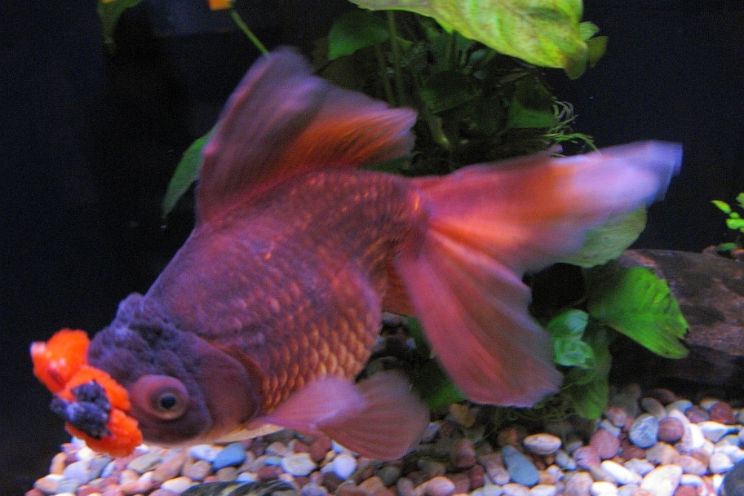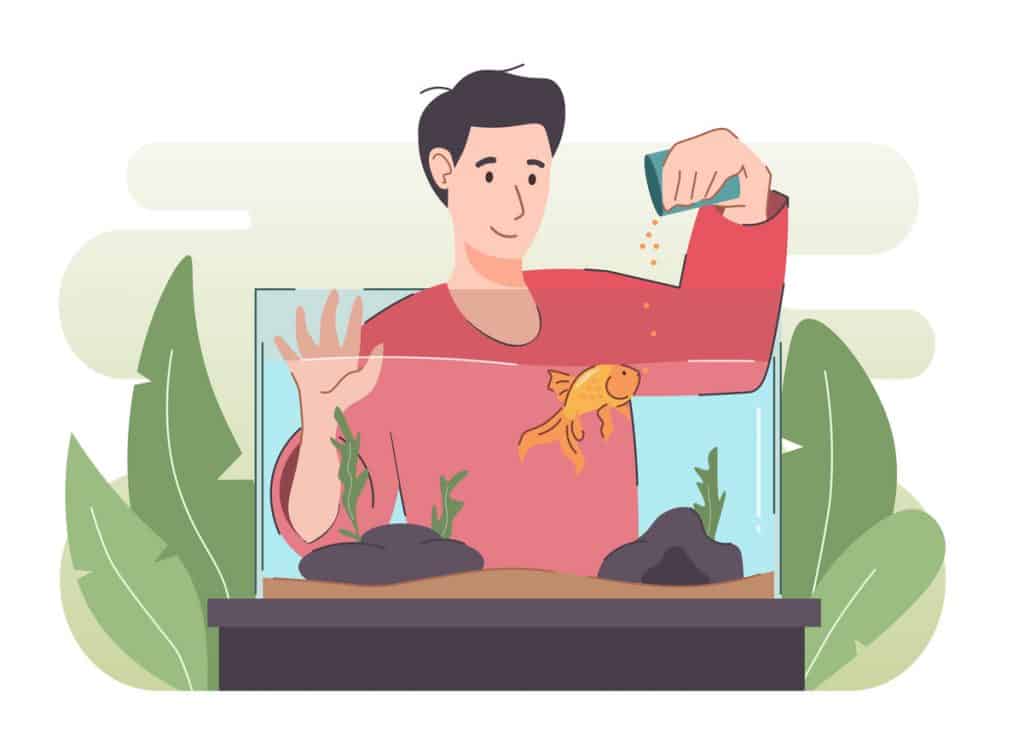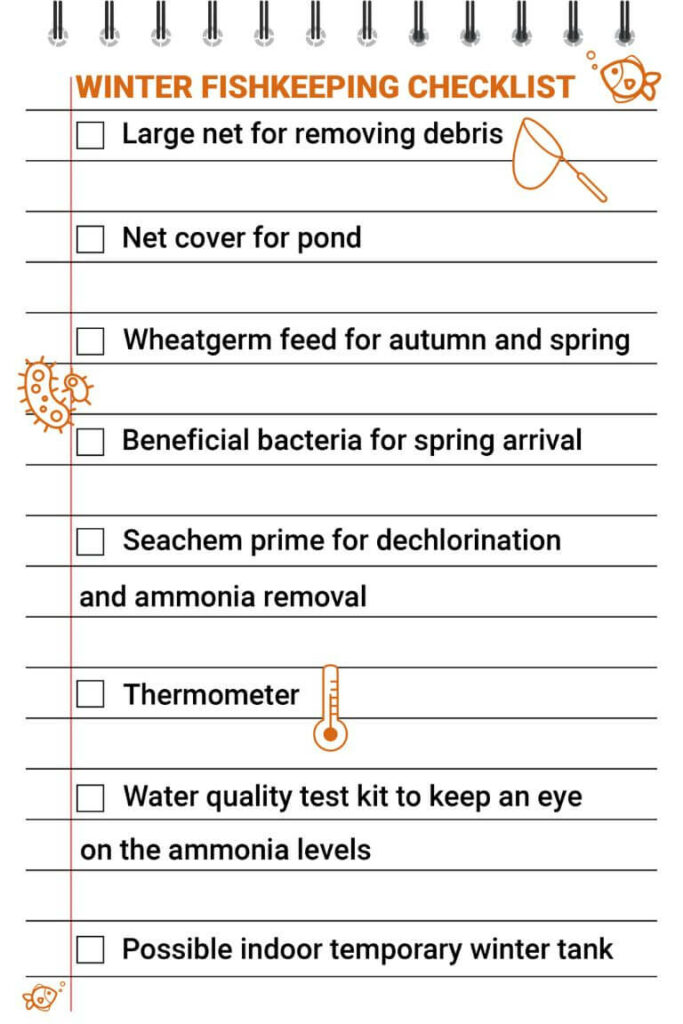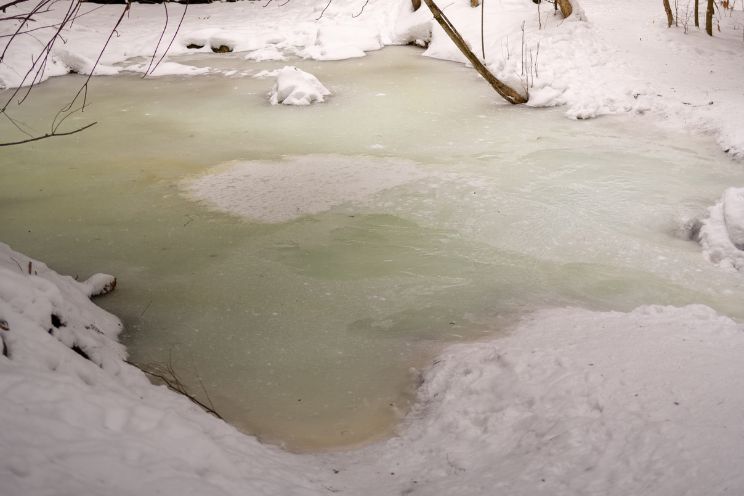In this guide, we aim to answer some commonly asked questions about your ponds and fish during the winter time.
Will pond fish survive the winter?
Depending on your setup, and the types of fish you decide to keep in your pond, this answer may be different.
You may need to take your fish inside over winter, or they may be able to live outside all year completely unphased.
Will fancy goldfish survive winter?
Typically, we advise you to take your fancy goldfish indoors over winter – this is because many breeds of fancy goldfish have specific health requirements due to their body proportions and bloodlines, which jeopardise their survivability in winter.
While it can certainly be done, we always recommend taking them inside during harsh winters.

Will baby goldfish survive winter?
Surprisingly yes, sometimes September spawns can survive through winter and live to see the next year.
Little guys dont always tend to do amazingly however, and many may die if they are born particularly late in the year.
Fry that do survive over winter you may find will be extremely strong and healthy fish, since they are the fittest ones who survived the harsh environment over winter.
If you want to breed your goldfish and keep all the babies though, you should take the eggs or fry inside over winter, as they do not have the fat reserves to enter torpor and will die.

Fish pond winterisation
Winter pond preparation
Getting your pond ready for winter involves a few maintenance changes to get it suited for harsh weather.
- The first thing to do is to start checking the temperature of your pond daily.
You should do this starting from mid-late autumn. Keep an eye out for when the water reaches temperatures below 10C / 50F; once this happens, the diet of the fish changes.
You should then begin regularly cleaning your pond, removing debris like dead leaves and organic material from the bottom of the pond. You can do this by dredging the bottom with a net.
- Tip: Just make sure to leave anything you remove on the side of the pond, so any tiny aquatic animals can get back in the water.
Should I cover my pond in winter?
A good idea for winterizing your pond is to create or purchase a cover for the pond – this can be either a net cover or plastic tarp to go over your pond during late autumn and winter which will block out wind and debris.
If you live in a place like:
- Canada
- Northern UK
- Scotland
- Some parts of North America
- Eastern Europe
- Some parts of East Asia
… then you may be subject to freezing winters. During this time, your pond may freeze over completely.
If this is the case for you, then we recommend getting a de-ice heater for your pond; these will float to the top of the pond and create a hole in the ice, allowing gaseous exchange to occur, supplying your fish with oxygen over winter.
You may also want to turn off your filter if you reach temperatures low enough to freeze running water.

Goldfish in winter
Do goldfish need a heater in winter?
In most cases no, your goldfish do not need a heater over winter; this is unless they have been moved out once winter has already begun, and need an extra boost to get them adjusted to outside temperatures.
It is possible to use a glass aquarium heater for a goldfish pond and slowly reduce it over time to acclimate them.
However, this is expensive to do and is dangerous to the fish’s health.
- We recommend against moving fish outside close to winter.
There are also pond heaters that aren’t designed to keep the water warm, but to prevent the pond from fully freezing over.
These are called de-icers and they are simple in design. They simply float like a buoy on the water’s surface, connect to an electrical outlet and output a level of heat, enough to prevent ice from forming around it.
By doing this, the heater creates a gap in the ice sheet which allows gases to exchange between the pond and outside atmosphere.
If you live in an area where your pond completely freezes over in winter, we highly recommend you get one of these!
How deep does a fish pond need to be for winter?
At least 3ft deep is the recommended height for a fish pond – this will prevent it from deep freezing and killing your fish, and it will allow them to get down and out of harsh weather throughout the year.
The deeper the pond the better really, however, be aware that once you get below 5ft, the oxygen level at the base of the pond will be very low.
As well as this, the pond also now opposes a threat to human health as you could drown in it!
Should I keep my pond filter running over winter?
This is really up to you, but, if you live in an area where temperatures are so low that running water freezes, then you should turn off your pump, as the ice will burst the pipes and cause harm to your filter.
For most places that don’t reach below -50 degrees in winter, then you are okay to leave the pond running. Leaving it running prevents ice from forming, improves gaseous exchange and keeps filtration active.
Keeping the filter on also disturbs the water and chills it on a deeper level; a still pond will be much warmer at the base than a pond with water movement.
It is entirely possible to leave your filter off over winter, just make sure that the water’s surface does not completely freeze over as the fish still need oxygen to breathe, which is dissolved from the outside environment.

Pond plants in winter
Do pond plants die in winter?
Plants are incredibly hardy organisms, they are able to withstand extreme weather conditions and seemingly cheat death. Over winter, different plants have different methods of coping with freezing temperatures.
There are 4 main categories of plants: Perennials, Deciduous, Annuals and Bi-Annuals.
Perennials are plants which will stay year round. They do not die back, but reduce their rate of growth during cold times. These plants are also called evergreens and keep their leaves all throughout winter.
Deciduous plants are those which stay alive throughout winter, but lose their leaves and foliage in the fall, reducing to bare stems. They may seem dead, but they are in hibernation and will return in spring.
Annuals are plants which only live for 1 year. They are born from seeds or spores usually at the start of the year in Spring; they grow, bloom, spread their seeds and then die in the winter. They will not come back, but their offspring will take their place the following year.
Bi-annuals are very similar in that they have a short lifespan, however, bi-annuals will live for 2 years. In the first year, they will grow only foliage and will be entirely leaves. In the second year they will bloom, spread their seeds and die.
Does duckweed die in winter?
Duckweed will mostly die off in winter, however, it will drop spores into the water column and will sometimes regrow in spring.
Some species of duckweed like “common duckweed” can survive freezing weather sometimes, whereas “lesser duckweed” has a harder time surviving the cold as they are a more tropical sub species.
How to winterize pond plants
Preparing plants for winter is different for each species.
How to keep pond plants alive over winter
Some plants need to be left out, as freezing is part of their life cycle. Others can be taken indoors to preserve them. Some plants you can get an additional year out of, if you prevent them from freezing.
- If you do keep them indoors over winter, pot them and keep them sat in water.
Perhaps fill a tray and sit the potted marginals in, and make sure they receive light everyday.
Most plants will be able to survive winter, however, and should come back each year provided they are deciduous or perennials.

Feeding pond fish in winter
Do goldfish eat less in winter?
In mid-late autumn, you need to begin feeding your fish wheat germ instead of their normal diet – this is because at below 10C / 50F temperatures, goldfish and koi cannot digest protein easily.
- In autumn, feed less than you normally would and keep your fish on wheatgerm.
During winter time, at temperatures below 5C / 41F, goldfish and koi cannot digest food at all, since the bacteria in their guts stops working and goes dormant.
Any food that the fish swallow during this time will now stay in their stomach all winter, until temperatures rise again.
This can be a serious risk to the fishes health, as the food can rot and swell, causing infection, impaction and bloat.
When to stop feeding pond goldfish for winter
Once the temperatures drop below 5C, you will notice your fish will be less active.
They will likely not rise to the surface for food and will stay around the bottom of the pond – this is because the fish have entered a state called torpor, where they are trying to conserve energy, until the warm temperatures return in the spring.
Around mid October is usually when the temperatures drop for most of the northern hemisphere – this is when you should switch over to wheat germ and keep a close eye on the temperature of your pond.
- Late November to early December is usually when you should then stop feeding completely and leave your fish to undergo torpor.
When to start feeding pond fish after winter
Around mid-late February, the temperatures will reach above 5C during the day, so it is time to begin feeding wheat germ again, however, be aware that in early spring, the temperature is unstable and up until mid-late April, the pond can still reach freezing temperatures.
- After the temperature has gone above 10C / 50F, then you can put your fish back on their normal diet!

Culturing live foods over winter
If you culture live foods outdoors like daphnia, bloodworm or mosquito larvae, then winter will stump your production of them.
Daphnia, worms, and the larvae of many flying insects will not survive over winter, and their parents will leave behind eggs which go dormant until spring when they hatch.
Although keeping mosquitoes in your shed to breed is not ideal, daphnia can be kept inside year round, as they do not leave the water and are easy to breed.
If you keep your culture in a tote or large container, then you can simply move them indoors when temperatures get too cold, to keep them going until spring.

Fish breeding in winter
Goldfish will not breed during winter; their last spawn of the year is usually around late September.
The babies may survive over winter and live to see the next year, but no spawning activity will take place.
Any babies born in September will have a somewhat tougher time during winter than babies born earlier in the year, so only the strongest will survive. If you want all the young to survive, you will have to take the eggs in and raise them indoors.
Many aquatic animals surprisingly do breed during winter however, one of these is the alpine newt, which only reach breeding condition when temperatures get below freezing!
Winter Fishkeeping Checklist
Preparing your pond and its inhabitants for winter may mean you need to get some extra pieces of equipment to make your life easier.
Here is a little winter checklist to help you find what you need:


Hello. I was just wondering if you could answer a question for me. We have a large goldfish that we are considering giving to someone who has a pond (he is getting too big for our tank). However, we live in an area with cold winters which concerns me. Would he do well being moved from an indoor tank to being out in the elements (cold temps/snow)? Also, I believe the only thing they feed their fish are the live plants that are in the pond. Would he need more food than that? I hate to get rid of him, but he is just getting too big for the tank and he needs more room, but I will worry about him. Thanks for any info you can provide.